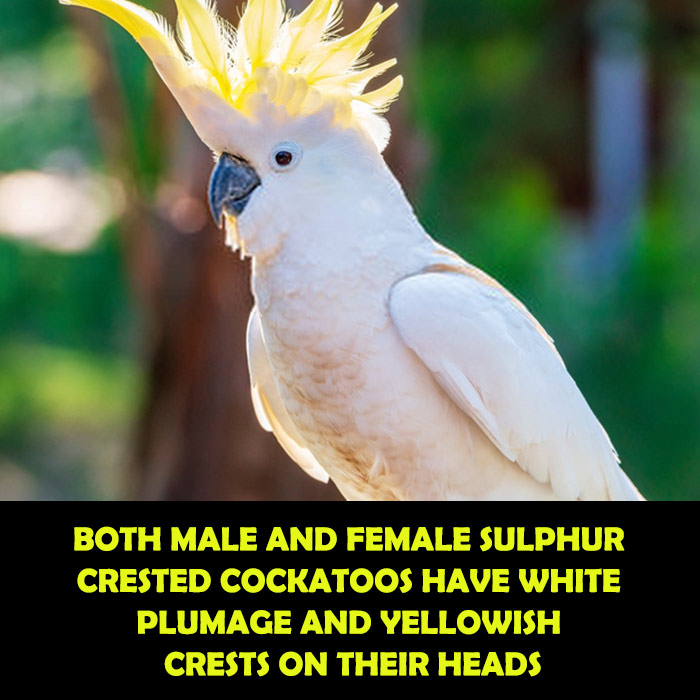The gender identification of Sulphur Crested cockatoos can be challenging as both males and females look alike; both genders have white plumage with yellow crest, under-wing, and tail feathers. But there are other ways to identify their gender.
Sulphur Crested cockatoo males and females can be identified from their eyes, beaks, and behavior. Moreover, DNA sexing can be performed for accurate results.
Now let’s talk about how you can identify them.

Physical Differences
Despite the resemblance between males and females, there are certain differences in their appearance. (1)
Feathers
The feathers of male cockatoos are more scattered and shinny than females.
Size
The male is generally bigger than the female. Its size is 44 to 55 cm, and the female’s size is 44 to 51cm.
Eyes
The male Sulphur Crested cockatoos have dark black eyes whereas the females have red-blackish eyes.
Beak
Males have bigger and darker beaks than females.
Pelvic Bones
Male Sulphur Crested cockatoos have close and pointy pelvic bones. The females have soft, rounded, and distant pelvic bones.

Vocal Differences
The male Sulphur Crested cockatoos have very harsh vocals. Their noise becomes unbearable when they scream. Females also have rough and shrill sounds, but males have more harsh vocals.
Furthermore, males are more talkative than females.
Behavioral Differences
Aggression
The female Sulphur Crested Cockatoos are usually humble and have gentle nature. Whereas males are generally aggressive. However, the females also get aggressive during breeding season as they experience hormonal changes.
Mating
During the mating ritual, the female cockatoo bends her back and lifts her head and tail; making it easier for the male to jump on her and mate.
Aside from the physical, vocal and behavioral differences, Sulphur Crested cockatoos can be sexed through DNA testing.
Identification of Gender By DNA Sexing:
The DNA test of a Sulphur Crested cockatoo is performed using a sample of their feather, toenail, or blood. The DNA sexing labs assess this sample to determine the gender.
Among all the methods of sexing cockatoos, DNA sexing is the most efficient and reliable method. Moreover, you can remotely get a DNA sexing test of your cockatoo; all you need is a sampling kit, take the sample, and ship it to the lab. Generally, DNA sexing a Sulphur Crested cockatoo costs $17-25 in the USA.
Conclusion
The gender of a Sulphur Crested Cockatoos can be identified through observation as both genders have certain differences in their physique, behavior, and vocals. However, the most accurate method of sexing is performing a DNA test.


How can you id the young of Cockatoos?
Ken it is really hard to identify a baby cockatoo’s gender as both genders look just the same. The only way to be 100% sure is to identify through DNA test. However, there are a few techniques that can be helpful. For example, the males have broad forehead, and big oval-shaped nostrils. Whereas a female has small round-shaped nostrils, and a small forehead.
Hi there,
Sulphur-crested cockatoos have been coming to our window during early spring for about five years. One year we were visited daily by a family of four.
This year only a single bird has shown up. He doesn’t appear to belong to a flock – we don’t hear any other cookies around when he’s here. I think it’s male because it tries to come in Every time but luckily understands my deep voiced NO! It’s also thrown things out of the window if we’re not there.
Anyway, he definitely has yellow cheeks (I haven’t seen under his wings) but we live in Sydney, Australia – isn’t he a bit far away from home? His beak is grey, narrow & the top over-hangs the lower bit.
Hi Louise. I believe the bird has been left behind by the flock and he is definitely not paired otherwise, he would have appeared with his mate at least once. By the appearance you have described, he seems like a young male.
As far as being a bit far away from home is concerned, yes, he is. But there are a few flocks of wild cockatoos living around Sydney.
Check this article: https://www.theguardian.com/environment/2021/jul/23/cockatoos-in-sydney-learning-from-each-other-to-bin-dive-for-food-study-finds